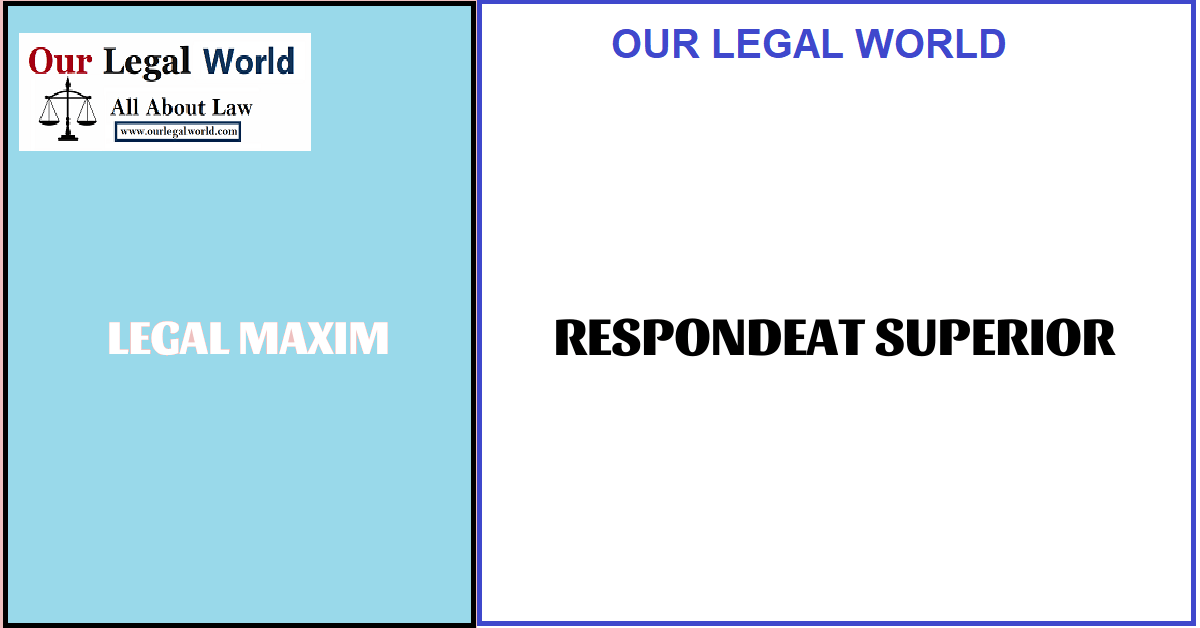Respondeat Superior- Legal Maxim:- Our Legal World
The liability of a superior for the acts of a subordinate.
We all live in a civilized society and hence all have some legal rights. The law ensures the enforceability of the same, through the liabilities. According to the law, liabilities can be classified into ‘direct liabilities’ and ‘vicarious or indirect liabilities’. The maxim respondeat superior is based on the concept of the vicarious liability.
If the principal ratifies the act, and the other person executes the same on behalf of the principal, though without any precedent authority, deemed to be the act of the principal. In such case the principal is bound by the act, whether it be to his disadvantage or benefit, and whether it be founded on a tort or a contract to the same magnitude as by, and with all the outcomes which follow from the same act done by his preceding authority.[i]
Why should a master be held liable?
In The Law of Torts,[ii] we can find three reasons mentioned
- The status of a servant maintains the marks of the history when he was a slave. The liability of the master for his servant’s torts is one instance. The notion that servant’s personality was merged in that of his master, which existed the era of enslavement.[iii]
- There should to be a remedy against someone who is able to pay the damages,[iv] and the master is anticipated to be in a better position, than the servant, for paying the damages.
- A third reason is expressed in the maxims respondeat Superiorand qui facit per alium facit per se. We have seen the thorough meaning of the later maxim in previous assessment. Let us now understand what the former one means.
Meaning of the maxim
The maxim literally means, “Let the principal answer” .
Worcester defines the term “superior” as meaning higher in dignity, or excellence (as) superior Court; official superior.
This maxim is more usually applied to actions of wrong, indicating a consequence of a tort, than which are founded in contract. Where, for instance, under the direction of principal, an agent commits a tortious act, each one is liable at the suit of the party injured; the agent is liable because his wrongful acts cannot be justified with the authority of the principal, and the principal who directed the act is liable under this rule of respondeat superior.[v]
According to W. Page Keeton, most of the Courts have made almost negligible efforts to explain the result, and have taken refuge in empty phrases, such as ‘he who does a thing through another does it himself,’ i.e. the formula of ‘respondeat superior,’ which literally means ‘look to the man higher up’.[vi]
Interpretations of the Maxim
Kumari Smt. vs. State of Tamil Nadu and others,[vii]
Facts: The appellant’s six year old son died as a result of falling in a ten feet deep sewerage tank in the city of Madras. There was no safety cover and the tank was left open. The appellant approached the Madras High court seeking a writ in the nature of mandamus directing the respondents to pay Rs 50,000 as compensation to the appellant. The High Court dismissed the petition on the ground that in the jurisdiction it was not possible to determine as to which of the respondents was negligent for leaving the sewerage tank uncovered.
The Appellant further approached the Supreme Court, in present case.
Held: While granting Special Leave, the Hon’ble Supreme Court, overruled the decision of the Madras High Court, observed that the writ jurisdiction, under Article 226 of the Constitution, can be invoked by the Writ Court for awarding compensation to the victim, who had to suffer due to negligence of the State or its functionaries. In the present case the SC rightly determined the responsibility of the State and directed the State to pay compensation.
Suman Panigrahi v. Board of Secondary Education, Odisha & Anr[viii]
Facts: The petitioner, belongs to a very poor family, appeared in the Annual High School Certificate Examination, 2013, in the results the petitioner declared as fail and in a paper of mathematics 06 marks have been awarded to him. Further he found that in total he has secured 412 marks out of 600. A revised mark sheet was issued by the Respondents, in which his marks in Mathematics answer script increased from 06 to 89, declaring the petitioner to have passed in 1st Division. The present writ petition is filed claiming compensation of Rs.5 lakhs for shock, mental agony and harassment caused to the petitioner and loss of one valuable academic year.
Held: The petitioner has a right to prosecute his study with dignity. The Board must ensure the education of the students with dignity. As the examiners were engaged by the Board, it would be appropriate to hold that the case is governed by the legal maxim respondeat superior and the Board is liable for the wrong committed by both the examiners and the Examination Committee.
Gold v. Essex County Council,[ix]
Facts: The plaintiff, an infant, was treated in such a hospital by a competent radiographer, who was full-time employee of the hospital, and due to failure on his part to apply adequate screening material in giving Grenz-ray treatment, the plaintiff sustained injury to her face.
Held: A local authority, carrying on a public hospital, owes to a patient the duty to nurse and treat her properly, and is liable for the negligence of its servants. Even though the negligence arises while a servant is engaged on work which involves the exercise of his personal professional skill. It was held that as the radiographer was a full-time employee of the hospital and hence the local authority was liable for his negligence under the doctrine of respondeat superior.
Also Read: Laxmi vs. Union of India and Ors.
Conclusion:
It can thus be deduced that it is a common-law doctrine that makes an employer liable for the actions of an employee when the actions take place within the scope of employment. In case of any wrong committed by the subordinate, the liability can be imposed on the person of a superior position, considering this doctrine of respondeat superior.
References
[i] PER TINDAL, C.J. in Wilson v. Tumman , (1843) 6 M & G 236 (242)
[ii] Ratanlal & Dhirajlal: Law of Torts
[iii] HOLMES, Common Law, pp. 179 (180)
[iv] Ibid.
[v] Latin for Lawyers
[vi] W. Page Keeton (5th ed. 1984), The Law of Torts, S. 69
[vii] AIR 1992 SC 2069
[viii] LNIND 2013 ORI 49
[ix] (1942) 2 KB 293




![Call for Campus Ambassadors by Our Legal World [2 Months; Virtual]: Apply by June 15](https://www.ourlegalworld.com/wp-content/uploads/2024/06/Logo-New-136x150.png)


